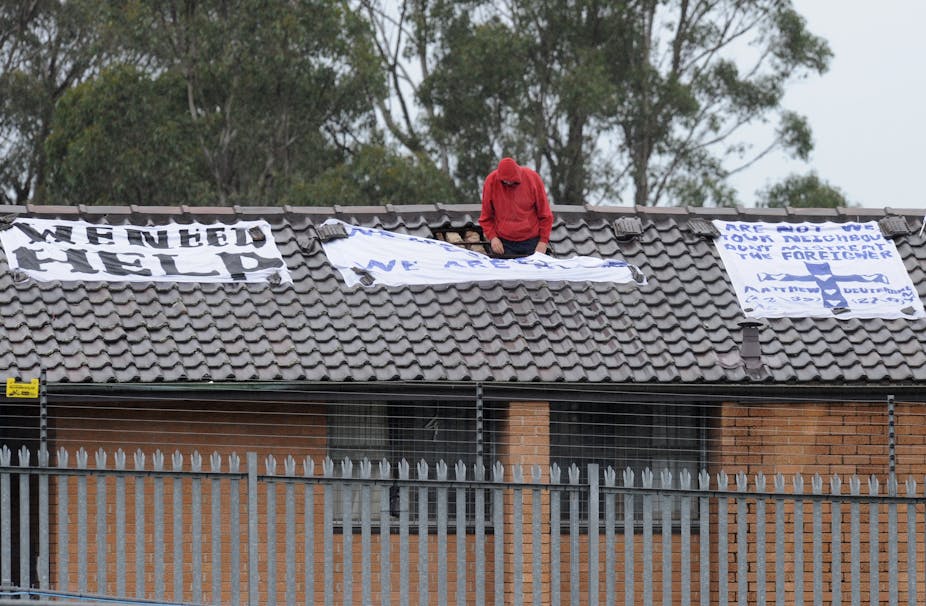With the collapse of offshore processing, and the likely increase in boat arrivals into a politically charged environment, a cross-road may have been reached regarding asylum policy in Australia.
Now would be a good time for politicians to lift themselves above their unedifying blame-game and unconvincing mouthing of adherence to the 1951 Refugee Convention, and to open a debate with the Australian people about the continuing relevance of this UN treaty.
After 60 years we need to ask whether the convention is still compatible with morally sound refugee and migration policy – or indeed with good governance.
Does it pose unacceptable risks in particular for Australia which has a tradition of managed entry?
Managing Australia’s borders
Our political leaders should be recommending and pursuing the Australian model of managed migration, including the resettlement of a sizeable annual quota of refugees, selected and processed off-shore.
Mandatory detention of asylum seekers was introduced in Australia in 1992 as an enforcement arm of new universal visa and regulated entry requirements.

It provided the means of separating “irregular maritime arrivals” and other “illegals” from properly visaed residents, visitors and citizens, while claims to remain in Australia were processed.
It made easier the removal of those whose applications for visas, including protection visas, were rejected.
The mandatory detention of those who arrive by boat (under the convention refugees may not be penalised for their mode of entry) has inflamed the humanitarian lobby.
It is destructive to those interred, massively expensive and no longer appears to be of much help with removals.
The immigration department currently has budgeted $1.3 billion for “detention and compliance operations”.
Of the 2,816 people released from immigration detention in financial year 2010-11, only 78 were released because they were “removed from Australia”.
In anticipation of increasing numbers, once all the detention centres are full, the government proposes to replace mandatory detention with bridging visas that confer work rights, access to Medicare and welfare.
It’s a capitulation. And welcoming new arrivals directly into the community will make the likelihood of removing those found not to meet visa criteria difficult, not to mention encourage others to come.
European model
The European countries that have received larger inflows over the last 30 years provide little comfort or guidance as to how Australia might operate its Refugee Convention obligations with integrity.

Germany, in 1992, received an absurd number of claims for asylum:450,000.
The UK received over 100,000 in 2001 and 2002.
Along with other Western European countries, they have since built up increasingly tough armouries of “externalised controls” or off-shore solutions, designed to keep asylum seekers from crossing their borders.
The Dublin regulation of 2003 requires asylum seekers to lodge claims in the first European Union country they reach.
“Safe Third Country” and “Safe Country of Origin” rules exclude asylum seekers who come from or through long lists of countries from lodging claims.
Through such exclusionary measures, the EU, along with other industrialised countries, has succeeded in drastically reducing its asylum claims.
In the last ten years the number of asylum claims lodged in industrialised countries has more than halved, to a total of 340,000 in 2010.
A briefing paper, produced in the UK earlier this year reported on a decade of attempts to “harmonise” asylum processes and structures in European countries. It raises the question whether there is any point continuing to pretend that it is possible to live up to the Convention’s expectations.
It notes “inadequate structures and processes” in many European states have “left refugees homeless, destitute and relying on charitable hand-outs, or, alternatively, incarcerated for prolonged periods in detention centres, with little concern for their physical and mental welfare.”
It also cites an “apparent increase in xenophobic and intolerant attitudes towards foreigners that has been exacerbated by the rise in irregular migration”.
In no-one’s interest
One of the many problems with the Refugee Convention is that it imposes no obligations to help refugees unless and until they are in a signatory country.
As asylum seekers have resorted to people smugglers and ever more determined illegal entry, the system has lost credibility in the public mind.

People can see that the refugee convention works neither in their national interest, nor in the interest of the world’s refugees.
Industrialised nations spend astronomical amounts of money on processing and supporting asylum seekers. In total, this is estimated to be more than ten times the funds the United Nations High Commission for Refugees UNHCR has to protect the 11.5 million refugees and 14.7 million “internally displaced persons” under its auspices.
Money spent by Western countries on their asylum systems would be better directed to supporting first countries of asylum, addressing protracted situations in refugee camps, and supporting the orderly return of refugees.
The UNHCR identifies each year 70-90,000 refugees in need of resettlement places; that is, people for whom returning home or integrating into a nearby country is not feasible.
If other countries adopted the Australian model, and accepted per-capita equivalents of our 14,000 off-shore humanitarian program, those most in need of resettlement would find places.
Withdrawing from the Convention
Article 44(2) of the Refugee Convention states that any contracting state can denounce or withdraw, with one year’s notice.
To prevent asylum seekers appealing directly to the courts after this time, a referendum might need to be organised to amend the Constitution, limiting access to the High Court to Australian citizens and permanent residents only.
Migration legislation would need to be changed. During this time the government could provide information, including for prospective asylum seekers, of its intentions.
After a specified date, people in Australia would not be able to apply to stay under the terms of the 1951 Refugee Convention – and may be detained and removed.
The same information campaign could describe how Australia will increase its support for countries of first asylum, including through the expansion of resettlement places. For which people could apply. Off-shore.

